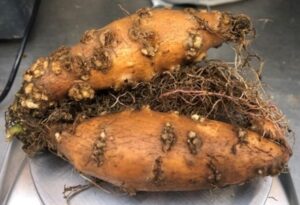Root-Knot Nematode Symptoms and Identification
Learn more about symptoms of root-knot nematode infection and how root-knot nematodes are identified to species!
Symptoms Associated with Root-Knot Nematode Infection

Credit: Sam Mowery
In sweetpotato, the presence of galls on the fibrous and storage roots is a significant symptom that indicates an infection by a root-knot nematode. Cracking on the storage roots is an additional symptom that may be present. The above-ground symptoms of root-knot nematode infection can include chlorosis, stunting, and plant death. It is important to note that the presence of galls on the fibrous and storage roots are the best indicators of root-knot nematode infection, as the above-ground symptoms are relatively nondescript and look like many types of nutrient deficiencies.
Root-Knot Nematode Identification
Although above-ground and below-ground symptoms are good visual indicators for root-knot nematode infection, the determination of the root-knot nematode species can only be done through molecular techniques. With this in mind, designated diagnostic laboratories are the best resources for the identification of root-knot nematodes to species via molecular techniques.
Identification of root-knot nematodes within the field or within infected plant tissue begins with collection. Soil samples from an infected field may be collected, packaged, and sent to a diagnostics laboratory for species identification. Like soil samples, infected plant tissue can be carefully removed from the field, packaged, and sent to a diagnostics laboratory. Depending on the diagnostics laboratory, there may be differing sampling or reporting instructions, so it is best to visit their website or call prior to sampling. Given Meloidogyne enterolobii’s status as an agricultural pest, which is under quarantine in North Carolina and Louisiana, it is important to be familiar with quarantine requirements as well.
Below are links to different diagnostic laboratories within each state associated with the SweetARMOR project.
North Carolina
North Carolina Department of Agriculture & Consumer Services (NCDA&CS) Nematode Lab
South Carolina
Clemson University Plant & Pest Diagnostics Clinic: Nematode Assay Lab
Louisiana
Louisiana State University AgCenter (LSU AgCenter) Nematode Advisory Service
Mississippi
Mississippi State University (MSU) Extension Plant Diagnostic Lab
California
California Department of Food and Agriculture (CDFA) Nematology Laboratory